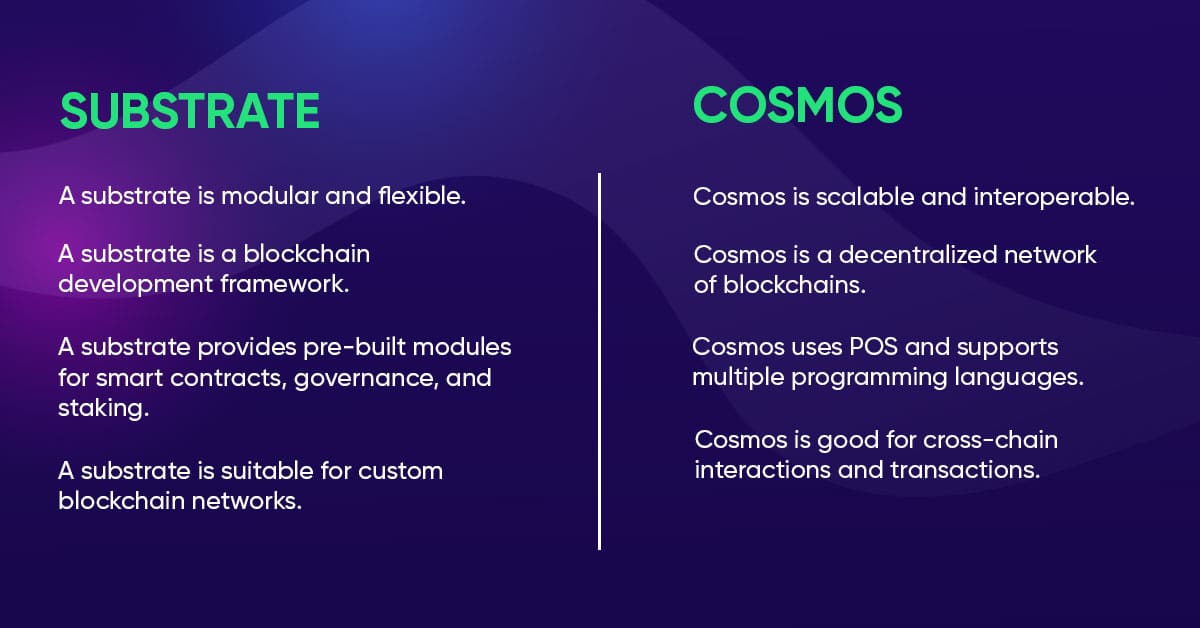
Introduction
Enabling The Decentralized Web Using Blockchain: Substrate Vs Cosmos
The decentralized web, called Web 3.0, aims to create a secure internet by leveraging decentralized technology. A vital aspect of this vision is decentralized infrastructure, which provides the foundation for decentralized applications (dApps) and decentralized autonomous organizations (DAOs) to function. Several frameworks and platforms are helping to enable the decentralized internet, two of which are Substrate and Cosmos. This blog post will explore two different decentralized infrastructures, compare their key features, and discuss their potential uses in the decentralized web. To better understand Substrate and Cosmos, let’s start by understanding decentralization.What is Decentralization?
Decentralization refers to spreading authority or power away from a central authority. In addition, when we use the term decentralization concerning the internet, it usually means giving control and management away from a central authority or organization and putting it into more hands, such as those of individual computer users. Moreover, Web 3.0 is the decentralized web or Web of Data. Web3 is a vision for how the internet could be structured, advocating new technologies like blockchain to create a more open and transparent environment. As a result, these technologies let users take control of their online data and interactions rather than relying on centralized platforms.
Substrate Framework for Decentralized Web
Firstly, the substrate is an open-source framework that helps build decentralized networks and applications: Parity Technologies, a blockchain company, released and developed this blockchain in 2018.Features of Substrate Blockchain
1. Modular Design
The substrate has a modular design that allows developers to customize and extend the framework for their specific needs easily. It has a pluggable architecture that enables developers to add or remove features, such as consensus algorithms and on-chain governance, as needed.
2. Support for Smart Contracts
Substrate support for smart contracts includes a built-in smart contract language called Polkadot Runtime Environment (PRE), which allows developers to create and deploy smart contracts on Substrate-based networks.
3. Strong Interoperability
Substrate support for cross-chain communication and the ability to connect to other blockchain networks makes it easy for Substrate-based networks to exchange data and assets with other blockchain systems.
Lastly, the Substrate framework offers a powerful and flexible platform for building decentralized applications and networks. Its modular design and support for smart contracts make it an attractive choice for developers looking to build on the decentralized web.Cosmos Blockchain For Decentralized Web
Cosmos creates a decentralized network of independent blockchains that are scalable and interoperable with each other. Interchain Foundation developed and launched the cosmos blockchain in 2019.Features of Cosmos Blockchain
1. Modular Design
Cosmos modular design enables developers to build and customize their blockchain applications easily. Moreso, It uses a modular framework called Tendermint Core, which provides the underlying consensus and networking layers for Cosmos-based networks.
2. Support for Interoperability
Cosmos blockchain provides support for interoperability between different blockchain networks. It includes tools and protocols called the Interchain Communication Protocol (ICP), which enables cross-chain communication and asset exchange between Cosmos-based networks and other blockchain systems.
3. Decentralized Governance Model
Cosmos’ decentralized governance model allows stakeholders to vote on network updates and upgrades. In addition, this enables the network to adapt and evolve in a decentralized and transparent manner.
Lastly, the Cosmos platform offers a robust, flexible solution for building and deploying decentralized applications and networks. Its modular design and support for interoperability make it an attractive choice for developers looking to build on the decentralized web.Comparison of Substrate and Cosmos
Substrate and Cosmos are decentralized infrastructure projects aimed at enabling the decentralized web. Yet, although they have some similarities, they also have some key differences.
Similarities Between Substrate and Cosmos |
Differences Between Substrate and Cosmos |
Both frameworks allow developers to customize and extend the platform for their specific needs. As a result, this makes it easier for developers to build decentralized applications and networks that meet their particular requirements.
Substrate and Cosmos have tools and protocols that enable cross-chain communication and asset exchange between different blockchain networks. As a result, this makes it easier for decentralized applications and networks built on these platforms to interact with other blockchain systems. |
Substrate blockchain focuses on building Polkadot-based networks, while cosmos focuses on building a decentralized network of independent blockchains.
The substrate has a more centralized governance model, with a foundation responsible for maintaining and developing the framework. Cosmos, on the other hand, has a decentralized governance model, with stakeholders able to vote on network updates and upgrades. |
Use Cases of Substrate and Cosmos For The Decentralized Web
Substrate and Cosmos have a wide range of potential use cases for the decentralized web. Here are a few examples:1. Decentralized Finance (Defi):
Developers can use substrate and cosmos to build decentralized exchanges, lending platforms, and other Defi applications. Their support for smart contracts and interoperability make them well-suited for these applications.
2. Supply Chain Management:
In retail, Merchants can use substrate and cosmos to build decentralized supply chain management systems that are transparent, secure, and efficient. For example, Merchants could use a substrate-based network that will help track the movement of goods through the supply chain, while merchants could use a Cosmos-based network to manage the flow of information and documents.
3. Identity and Access Management:
Government can use substrate and cosmos to build decentralized identity and access management systems that are secure and user-friendly. For example, a Substrate-based network can store and manage digital identities, while a Cosmos-based network can control access to resources and services.
4. Social Networking:
Users can use substrate and cosmos to build decentralized social networking platforms that are more private and secure than their centralized counterparts. For example, a Substrate-based network can help store and manage user profiles, while a Cosmos-based network can facilitate communication and content sharing.
Conclusion
To conclude, the decentralized web is a rapidly growing movement, and we expect its proponents to introduce new technologies in the next few years. In addition, Decentralized infrastructure is a vital component of the decentralized web, providing the foundation for decentralized application development and organizations to function. Substrate and Cosmos are two important blockchains, offering robust and flexible platforms for building decentralized networks and applications. There are many companies offering blockchain development services, but as we have discussed above, both blockchains have a lot to offer, having some key differences at the same time that developers should consider when choosing a platform for their projects. Stay tuned with BloxBytes!
Stay tuned with BloxBytes!
